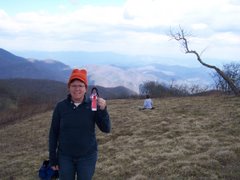Jessica Williams & Donna McCusker
Whitefield School
Whitefield, NH
September 22
As rain showers splashed against window panes, most people slept soundly on an early Sunday morning. However, an intrepid group of students and their teachers met at the Highland Center at the foot of the White Mountains for an adventure of a lifetime. This was the day that eight middle school students from the Whitefield School Wilderness Explorers were to begin their leadership summit to Mizpah Hut and Mt. Pierce. Teachers Donna McCusker and Jessica Williams organized the leadership summit as part of their project for Trail to Every Classroom. The training that they received at TTEC, their partnership with the Appalachian Mountain Club and funding from a grant through the Waterman Fund enabled the teachers to offer this valuable experience to their students.
Joined by Whitefield teacher Ashley Guilbeault and TTEC advisory council member Janet Steinert, the teachers and students met their AMC guides, Matt Maloney and Olivia Bronson. Mrs. McCusker and Ms. Williams had met with AMC staff earlier in the summer to plan out instruction that would provide students with curriculum content from the Common Core, intertwined with instruction on leadership skills while participating in a rigorous climb to a mountain summit. Students learned to read a map, using topographical cues to predict the terrain ahead; to use mathematical skills in the reading and setting of a compass; and to communicate effectively as a group and as student leaders. Additionally, students practiced the tenets of Leave No Trace while gaining a full appreciation of their environment and of wild spaces.
After some introductory exercises at the Highland Center and a backpack check to make sure everyone was well equipped, the group set out on the Crawford Path. They began at a sign that provided a history of the path, explaining that the path was the oldest trail in continuous use in the US. In 1819, Abel Crawford and Ethan Allen completed the Crawford Path, which led to the summit of Mt. Washington, the highest point along the Appalachian Trail north of the Mason-Dixon line. The group slowly climbed up the flank of the mountain, stopping to learn a new concept or to engage in another leadership exercise.
As the students neared Mizpah Hut, the path joined the Appalachian Trail. Some students exclaimed that they planned to thru hike the AT when they were older. Matt and Mrs. Steinert had hiked the entire AT and were happy to share their experiences with the students. Shortly after reaching the junction, the students reached the hut and entered quietly. After settling into their assigned bunkrooms, the students joined other guests for a scrumptious dinner of stuffed shells, salad, soup, homemade bread with real butter, and a surprise dessert. The students ate heartily, hungry from a day of hiking in wet conditions.
That evening, students met in the library for a game of Trivial Pursuit, reviewing the concepts they had learned that day. With energy waning, the students turned in early and quickly settled down for the night—not a common thing for middle school students. But these kids were tired. They had had a full day of physical and mental exertion.
After breakfast the next morning, the group packed up and began a steep climb along the Appalachian Trail up the side of Mt. Pierce, into the alpine zone at 4310 feet high. At the summit, the rain stopped long enough for the students to take a snack break and to rest before descending 3.1 miles to the Highland Center. Matt and Olivia cautioned the students to only step on “durable surfaces,” rocks, for the fragile alpine environment could not endure the tread of hiking boots. Matt described the flowers and plants that survive the harsh climate and that can only be found in the Arctic and here in the alpine zone of the White Mountains. With a new appreciation of their environment, the students stepped lightly as the rain pounded down upon them.
As the group picked along the boulders during their descent, students chatted merrily, stumping each other with mind-boggling riddles while stopping to drink water or to eat. As they neared the end of the trail, Olivia gathered the group for one last exercise. She instructed the students to reflect upon what they had learned and to recognize a group member for something special that that person had given during this expedition. One young man announced that he had gained a “passion for the wilderness,” and the group quietly nodded in agreement. This had been an experience that these young students would not ever forget.
Welcome to the Trail To Every Classroom Blog! This space was created for teachers and educators to share information, resources and curricula in using the Appalachian Trail as a learning tool. We welcome all questions, ideas, techniques, lessons learned and enthusiasm surrounding Place-Based Education and Service Learning on the A.T.
Subscribe to:
Post Comments (Atom)
North Carolina NCCAT participants

At the Wayah Bald Fire Tower
Mary Jane

On top of Silers Bald

No comments:
Post a Comment